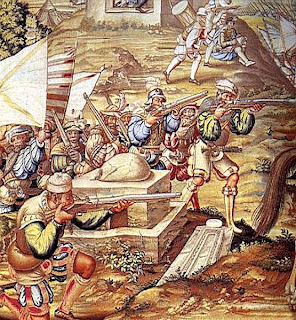Dr Stillfried started with some technicals on tapestry and the importance of this particular set in their massive size, woven with the best quality colors, best material and by the best weavers.
She then exhibited the main actors: Charles V emperor, Soliman the magnificent, Sultan of the Ottoman empire, Hayreddin Barbarossa, the pirate turned into Pasha and Admiral in control of the Mediterranean sea, Muley Hasan, governor of Tunis defeated by Barbarossa, Jan Cornelisz Vermeyen, artist commissioned to make the most exuberant tapestry with full account of the battle, and some other minor actors.
Vermeyen went to the battle with the troops in june 1535 and recorded scenes in hundreds of drawings none of which have survived. He then drew the real life size cartouch, a template for weavers. These cartouch were used a first time for a set of tapestry in the 16th century on display today in Madrid at the Patrimonio National and the second time in the 18th century for another set on display in Vienna.
Agnes Stillfried went through many details that caught her eye: like women washing on the side of a battle, or why the young page wore an oversized helmet, or the details of the Santa Anna, the largest ship of the century, or ostriches next to the goats, or the fabric and fashion of the moment etc.
Tunis was conquered by Charles V, but Agnes Stillfried gave another historical perspective and reality: Barbarossa was still at large and ruling over the Mediterranean after his loss of Tunis and this battle did not have a significant impact on politics of that time. "It looks like political propaganda." she says. Charles V tried to market himself as extraordinary Emperor, and he succeeded, among other achievements, in leaving an artistic legacy that you should see if given the opportunity.

No comments:
Post a Comment